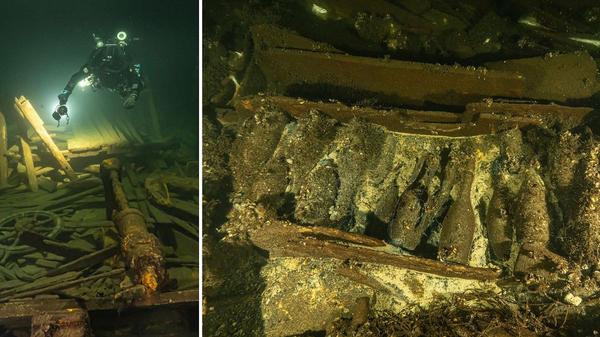Divers have found a large number of bottles of champagne and mineral water dating back around 170 years in a sunken sailing ship in the Baltic Sea.

A large number of unopened champagne bottles were found in an ancient shipwreck in the Baltic Sea. Photo: Tomasz Stachura/Baltictech
During a dive off the coast of Sweden, the Baltictech diving team from Poland discovered the ancient shipwreck using sonar equipment in the Baltic Sea, about 37 km south of the Aland Islands, Independent reported on July 26. The sailing ship was still in good condition, carrying about 100 bottles of champagne, 100 bottles of mineral water and ceramics.
“I’ve been a diver for 40 years and occasionally I’ll find a bottle or two. But discovering a shipwreck with so much cargo is a first for me,” said Tomasz Stachura, the dive team leader.
The mineral water was contained in clay pots, allowing experts to date the shipment to 1850-1867. It was produced by the German company Selters and may provide clues to the ship’s owner. “At that time, mineral water was considered almost medicinal and was often reserved for royal dining tables. Its value was so great that shipments were escorted by police,” the dive team explained.
Stachura speculates that the special shipment may have been en route to Stockholm or St Petersburg, serving Tsar Nicholas I of Russia, who is said to have lost a ship in the area in 1852.

The dive team has notified local Swedish authorities of the discovery, but they may not be able to open the bottles of ancient champagne just yet. Stachura said further exploration and recovery of the cargo would take time due to administrative constraints. “They’ve been there for 170 years, so let’s leave them there for another year and we’ll have time to prepare better for this operation,” he said.
But even if the divers get a chance to taste the champagne, its quality will be “a game of chance,” according to Leta Bester, director of the London Wine Institute. Factors such as cork integrity and underwater storage conditions can affect the condition of the champagne, he said.
“How well a wine ages depends a lot on the quality of the wine to begin with. If it’s a top-quality vintage champagne, there’s a higher chance that some of the bottles will still be usable,” says Bester. Most nonvintage champagnes aren’t made to age, he says, so it’s impossible to judge without knowing what kind of wine they are in the first place.
Bester said that if the bottles remain sealed and uncontaminated, champagne is unlikely to cause harm. However, he noted that it is extremely important to test samples in a controlled environment to ensure they meet modern safety standards. Wines also lose their bubbles over time, and the condition of each bottle can vary.




